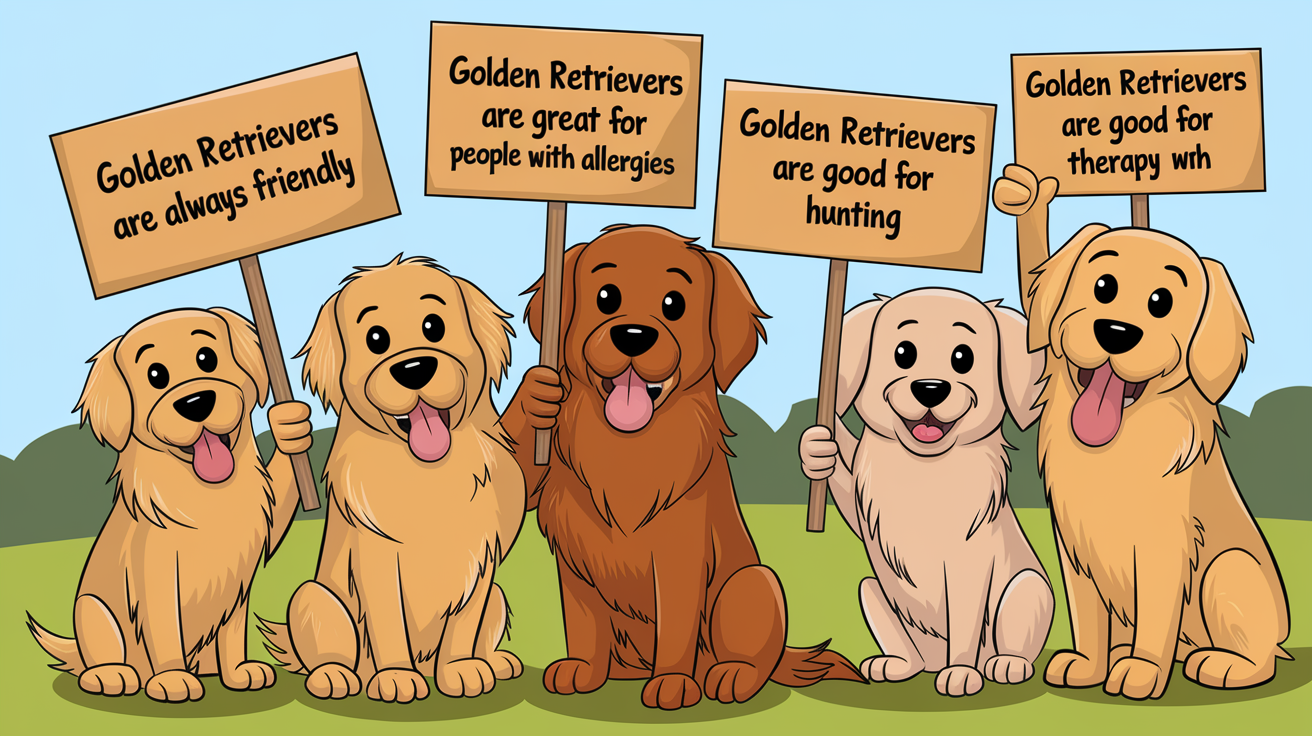Golden Retriever Breed Surprising Traits. Golden Retrievers are often recognized for their shining coats and affectionate nature, making them a favorite among dog lovers. What many may not realize is that these dogs possess a range of traits that go beyond their friendly demeanor and iconic appearance. From their origin as skilled hunting companions to their modern-day roles, Golden Retrievers have consistently demonstrated a versatility that surprises even the most knowledgeable dog enthusiasts.

While they are celebrated for their luxurious double coat and the predisposition to excel as therapy dogs due to their empathy and love, Golden Retrievers also have unique physical characteristics that contribute to their capabilities. For instance, they possess water-repellent fur and “duck-like” feet which aid in swimming—a testament to their breeding for waterfowl retrieval. It is such distinctive traits that underscore the Golden Retriever’s dynamic nature and adaptability across various roles and environments.
Origins and History
https://www.youtube.com/watch?v=Gzwi4pwPQsA&embed=true
The Golden Retriever breed boasts a rich tapestry of history, intertwined with Scottish heritage and aristocratic influence. Their journey from the Scottish Highlands to global popularity is a testament to their versatile abilities and endearing nature.
Scotland’s Contribution to the Breed
Scotland in the 19th century was the crucible where the Golden Retriever was forged. The breed owes its origins to the Scottish Highlands, where hunting was not only a sport but a way of life. Lord Tweedmouth, whose real name was Dudley Marjoribanks, is credited with the development of the Golden Retriever. His vision was to create a breed that could adeptly navigate the rugged terrain and assist in hunting waterfowl.
- Nous – The foundational sire of the breed was a yellow-colored retriever named Nous, bred by Lord Tweedmouth.
- Tweed Water Spaniel – These now-extinct dogs were integral to the breed’s lineage, contributing their retrieving skills and likely their love for the water.
Development and Recognition
Over the years, refinement of the breed continued, with the aim to enhance their retrieving abilities and adaptability. The American Kennel Club (AKC) formally acknowledged the Golden Retriever in 1925, marking a significant milestone in the breed’s history.
- Recognition: In the early 1900s, the breed started to gain recognition at dog shows, initially categorized as “Retriever- Wavy or Flat Coated” before obtaining official status.
The history of the Golden Retriever reflects a blend of exceptional skills and a warm, personable nature, securing their place as both beloved family pets and capable working dogs. Their origins, from the vision of Lord Tweedmouth in the Scottish Highlands to their widespread adoption in America, highlight their evolution into one of the most cherished breeds today.
Personality and Character
https://www.youtube.com/watch?v=54B_Nv6QLI4&embed=true
Golden Retrievers are often celebrated for their amiable and gentle nature. Delving into their personality, one finds a breed that excels in both friendliness and intelligence, making them a favorite among families and individuals alike.
Temperament and Behavior
Golden Retrievers exhibit a temperament that is both affectionate and obedient. This breed thrives on interaction with their owners and is consistently friendly towards both humans and other animals. Their playful behavior is complemented by a calm disposition, particularly when they are well-trained and get regular exercise. They are characterized by their loving nature which makes them excellent companions.
- Affectionate: Highly responsive to their family’s emotions and always ready to provide comfort.
- Playful: Eager to engage in games and activities, displaying their joyful personality.
- Gentle: Known for their soft approach, especially around children and the elderly.
- Obedient: With the right training, they are excellent at following commands and participating in obedience trials.
Golden Retriever Interactions
Their interactions with families and especially kids stand out as a hallmark of the Golden Retriever personality.
- Good with Children: Their patience and gentle behavior make them an ideal choice for households with children.
- Social with Other Pets: Typically get along well with other household pets and dogs.
- Eager to Please: This trait makes them highly trainable, reflecting their intelligent nature.
Golden Retrievers reach their full potential when they receive attention, exercise, and proper training. Their personality traits resonate well in environments where they can be part of daily activities and are included as members of the family.
Physical Attributes
Golden Retrievers are a well-known dog breed recognized for their striking appearance and sturdy build. Here, we’ll explore their breed standards and general health, which contribute to their popularity and affectionate presence in the homes of many.
Breed Standards and Appearance
The American Kennel Club (AKC) sets clear standards for Golden Retrievers, focusing on their physical traits. Males typically stand between 22 to 24 inches in height while females are slightly shorter, ranging from 21.5 to 22.5 inches. Their weight reflects their medium to large size, with males weighing in at 65 to 75 pounds and females between 55 to 65 pounds.
Golden Retrievers possess a dense, water-resistant outer coat with a softer undercoat that enables them to retrieve game in water and keep warm. Their coats come in various shades of gold, from light cream to a darker golden hue. These dogs usually have a balanced and symmetrical appearance, with straight or wavy outer coats that shed seasonally.
Health and Lifespan
Golden Retrievers tend to live between 10 to 12 years on average. During their lifespan, they can be prone to certain health issues. Canine hip dysplasia, a genetic condition affecting the hip joint, is relatively common among them. They are also susceptible to various forms of cancer, which are among the leading causes of death in the breed.
While shedding can be prolific, especially seasonally, it also indicates the general health of the dog. Regular grooming can help manage shedding and also provide a good opportunity to check for any emerging health issues. Golden Retrievers may also face heart disease among other health issues, so proactive and regular veterinary care is essential for their well-being and to manage preventable diseases effectively.
Caring for a Golden Retriever
Golden Retrievers thrive with proper care that satisfies their dietary, exercise, and grooming needs. Attention to these areas can ensure that they lead a healthy, active, and happy life.
Nutrition and Diet
Golden Retrievers require a balanced diet rich in nutrients to maintain their energy levels and overall health. High-quality dog food with the right balance of protein, carbohydrates, and fats is essential. They often benefit from diets including fish, lean meats, brown rice, and vegetables, which provide the necessary nutrients for their active lifestyle. Portion control is important too, as Goldens are prone to obesity.
Exercise and Training
Being an energetic and active breed, Golden Retrievers need regular exercise to stay fit. Daily walks, swimming, and a good game of fetch keep them physically and mentally stimulated. They excel in dog sports such as agility due to their high intelligence. Consistent obedience training from a young age helps harness their energy into positive behaviors.
Grooming Essentials
Regular grooming is crucial to prevent matting and reduce shedding. Brushing their coat a few times a week and more frequently during shedding season helps to keep their fur clean and manageable. It’s important to check their ears to prevent ear infections, and their nails should be trimmed regularly to avoid discomfort.
Golden Retrievers in Society

Golden Retrievers have woven themselves into the fabric of society through a variety of important roles, from service and assistance to comfort and companionship.
Roles and Services Provided
Golden Retrievers are renowned for their service and contributions across many facets of human life. As service dogs, they are trained to perform tasks for individuals with disabilities, such as helping a person who has mobility issues to pick up items, open doors, or provide stability when walking. The American Kennel Club recognizes their aptitude as working dogs due to their intelligence and trainable nature.
In the realm of therapy, Golden Retrievers serve as therapy dogs visiting schools, hospitals, and nursing homes to offer emotional support. Their naturally friendly and gentle temperament makes them ideal for providing comfort and reducing stress among patients and students.
Moreover, they contribute actively to rescue operations as search and rescue dogs. Their keen sense of smell, endurance, and drive enable them to assist in locating missing persons during disasters and in wilderness areas.
Golden Retrievers also play a significant role in sports and outdoor activities in America. As hunting dogs, they were originally bred to retrieve waterfowl during hunting trips — a task they still excel at today due to their soft mouth grip and love for water.
Aside from these working roles, in family settings across the United States, Golden Retrievers are cherished as family dogs and loyal companions, bringing endless joy and affection into homes. Their adaptability and friendliness have cemented their status as one of the most popular dog breeds in the country.
Frequently Asked Questions

In this section, discover the distinct qualities and common curiosities about Golden Retrievers, ranging from their unique characteristics and typical temperament to their original breeding purposes, health issues, renowned traits, and the variation between different Golden Retriever varieties.
What unique characteristics distinguish Golden Retrievers from other breeds?
Golden Retrievers are recognized for their dense, water-repellent golden coats and their keen retrieving abilities, which set them apart from other breeds. According to the American Kennel Club, their exuberant puppy behavior often lasts into adulthood, contributing to their endearing personality.
How would you describe the typical temperament of a Golden Retriever?
Typically, a Golden Retriever exhibits a friendly, loyal, and patient temperament. They are also notably intelligent, making them easy to train and great family pets as they interact well with children and other animals.
For what purposes were Golden Retrievers originally bred?
Golden Retrievers were originally bred in 19th century Scotland with the aim to create a skilled retrieving dog. They were intended for both hunting and companionship, needing to navigate the rugged Scottish terrain and variable weather conditions effectively.
Can you highlight any common health issues specific to Golden Retrievers?
Golden Retrievers may be prone to certain health issues like hip dysplasia, heart problems, and specific cancers. Ensuring regular veterinary check-ups and maintaining a healthy diet and exercise regimen can help mitigate some of these risks.
What are some noteworthy traits Golden Retrievers are known for?
Some of the most noteworthy traits of Golden Retrievers include their versatility as working dogs in roles like search and rescue, their aptitude as service animals, and their all-around friendly nature which makes them excellent therapy dogs as well.
How does the American Golden Retriever variety differ from others?
The American Golden Retriever variety is known for its lustrous golden coat. It is generally less dense than its British counterpart. American Golden Retrievers are also typically leaner and taller, and they may exhibit slight variations in temperament and activity levels.









